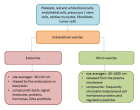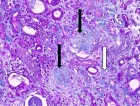About University Clinical Centre of Kosovo
University Clinical Centre of Kosovo
Articles by University Clinical Centre of Kosovo
How often is Klippel-Feil Syndrome associated with congential heart disease presentation of five cases and a review of the literature
Published on: 3rd September, 2019
OCLC Number/Unique Identifier: 8270717914
Introduction: Klippel-Feil syndrome (KFS), is a bone disorder characterized by the abnormal joining (fusion) of two or more spinal bones in the neck (cervical vertebrae), which is present from birth. Three major features result from this abnormality: a short neck, a limited range of motion in the neck, and a low hairline at the back of the head. In some individuals, KFS can be associated with a variety of additional symptoms and physical abnormalities which contribute in the deterioration and complication of the condition of the child.
Aim of presentation: Here, we report five children from Kosovo with KFS associated with different heart abnormalities, clinical presentation, diagnosis, management, and outcomes of selected conditions in resources-limited settings.
Methods: Retrospectively we analysed medical reports of five children, diagnosed at different age with congenital disease and clinical and lab signs of Klippel-Feil syndrome.
Conclusion: Basing on our cases, all diagnosed in a small country as a Kosovo, we can conclude that KFS is not such a rare condition. In addition, such syndrome is not so rarely associated with different congenital heart disease. In four cases cardiac surgery was indicated and successfully was done abroad Kosovo in the lack of such services in Kosovo.
Emergency care sick palliative and problems oncology in emergency department during the COVID-19 pandemic
Published on: 30th September, 2020
OCLC Number/Unique Identifier: 8873202033
Emergency medical care in palliative patients during the COVID-19 pandemic, it is important to provide a consistent treatment for stable patients that should be consistent with the goals and benefits, the perspective of these patients, but avoiding palliative patients with a poor prognosis that is unlikely to survive. Cancer is the second leading cause of death in the world around 8.8 million deaths a year. Worldwide, about 7-10 million patients are diagnosed with cancer each year, recently there has been a significant increase in the number of cases diagnosed with cancer. About 70% of cancer deaths are in low- and middle-income countries. The goals of emergency medical care based on the criteria of BLS and ACLS, that is should be done “Do not do resuscitation, do not intubate but continue medical treatment excluding endotracheal intubation without prospects for the patient, but offering BLS only treatment concentrated symptomatic. ED is often the only place that can provide the necessary medical interventions (e.g., intravenous fluids or pain management medications. Medications as well as immediate access to advanced diagnostic tests when needed such as CT, RM and other diagnostic and treatment procedures.
The Death of a Baby from the Congenital Anomalies of the Urinary Tract
Published on: 22nd February, 2018
OCLC Number/Unique Identifier: 7735844397
A 36-year-old woman pregnant, G2 P1, presented at 27 weeks of gestation after two previous visits elsewhere, as an outpatient in a gynecological clinic. An ultrasound examination revealed bilateral hydronephrosis. Also, ureteral dilation and bladder overdistension was present (Figures 1-3). We evaluated that the cause was a urinary tract obstruction. Specifically, we are dealing with posterior urethral valves. The anteroposterior diameter of the pelvis on a transverse view of the abdomen was 6 mm. The amniotic fluid index (AFI) was 3 cm, so, oligohydramnios.
Trichomonas Vaginalis-A Clinical Image
Published on: 21st July, 2017
OCLC Number/Unique Identifier: 7317592100
A 32-year-old G4P301LC3 woman presents to the office for a visit, with a 6-day history of vaginal discharge with an unpleasant odor. On speculum examination, the discharge was green in color and frothy in appearance. Is noticed vulvar erythema, edema, and pruritus, also is noted the characteristic erythematous, punctate epithelial papillae or “strawberry” appearance of the cervix. Vaginal pH was 6.2. Diagnosis of Trichomonas vaginalis is made via wet prep microscopic examination of vaginal swabs.But also, for diagnosis help even the exam with the speculum, concretely “strawberry” appearance of the cervix. The diagnosis is confirmed by culture.Trichomoniasis is a sexually transmitted infection [1,2], that caused by trichomonas vaginalis. Trichomonas vaginalis is a unicellular, anaerobic flagellated protozoan, that inhabits the lower genitourinary tracts of women and men, but that can cause vaginitis. Clinical findings of Trichomonas vaginalis include a profuse discharge with an unpleasant odor. The discharge may be yellow, gray, or green in color and may be frothy in appearance. Vaginal pH is in the 6 to 7.Vulvar erythema, edema, and pruritus can also be noted. The characteristic erythematous, punctate epithelial papillae or “strawberry” appearance of the cervix is apparent in only 10% of cases. Symptoms are usually worse immediately after menses because of the transient increase in vaginal pH at that time. Diagnosis of Trichomonas vaginalis is made via wet prep microscopic examination of vaginal swabs. Other, more sensitive tests are available, including nucleic acid probe study and immunochromatographic capillary flow dipstick technology. The diagnosis can be confirmed when necessary with culture, which is the most sensitive and specific study. Nucleic acid amplification tests (NAATs) have replaced culture as the gold standard. T vaginalis NAATs have been validated in asymptomatic and symptomatic women and are a highly sensitive test [3]. Because the Trichomonas vaginalis is a sexually transmitted infection, both partners should be treated to prevent reinfection. The mainstay of treatment for Trichomonas vaginalis infections is metronidazole. Treatment schemes can be:

If you are already a member of our network and need to keep track of any developments regarding a question you have already submitted, click "take me to my Query."




















































































































































